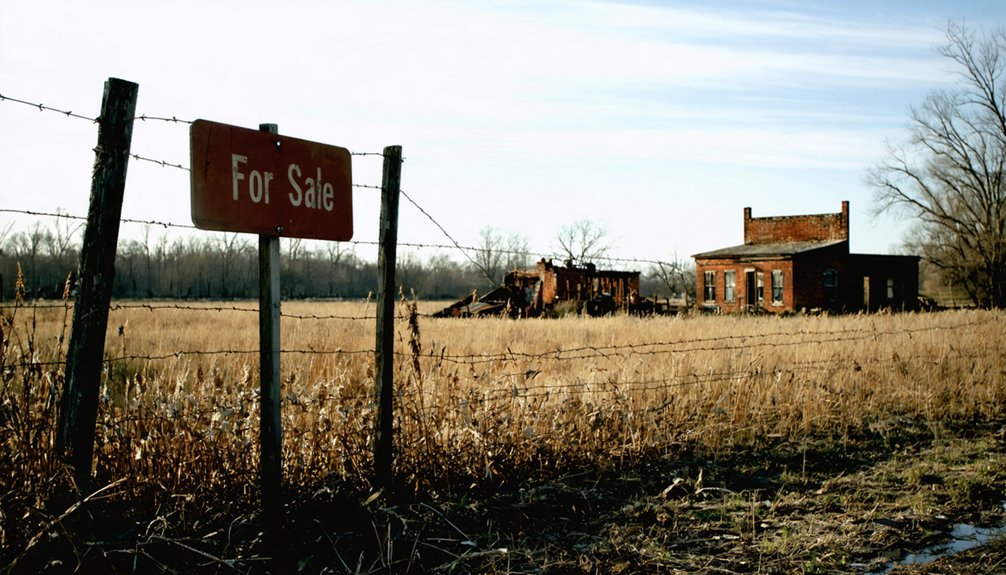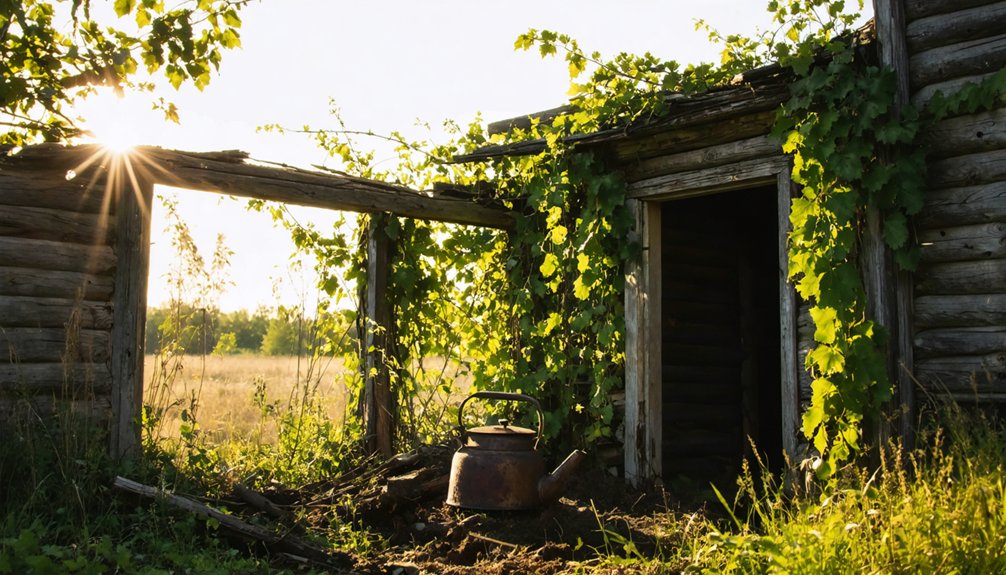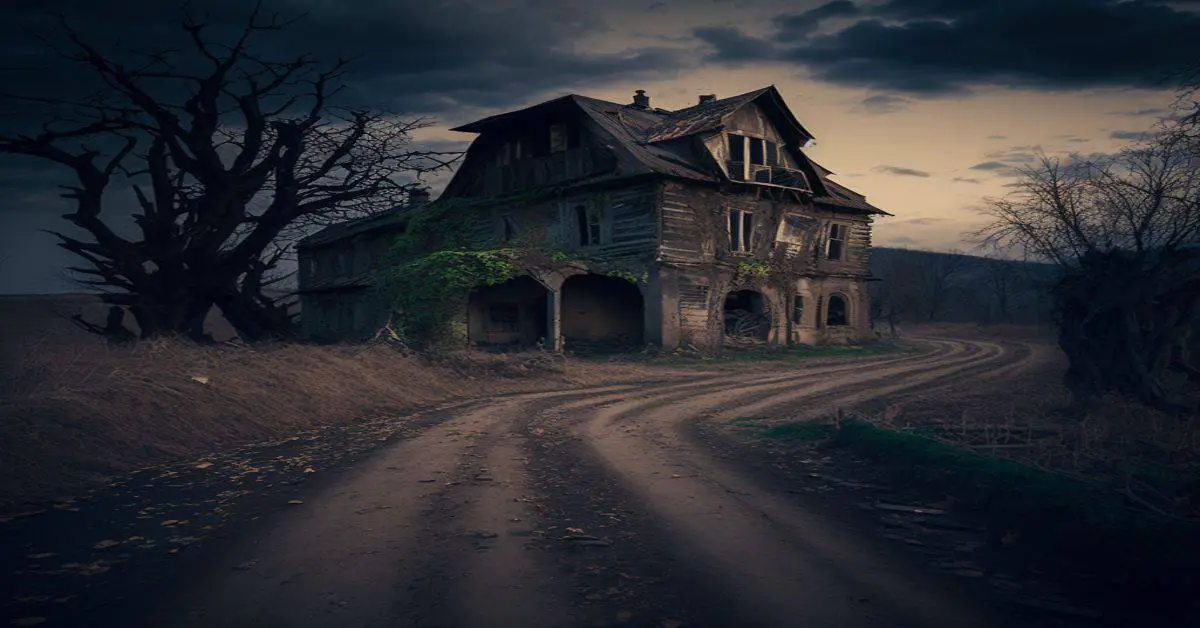You’ll find Piankashawtown’s remains 4 miles northwest of Albion in Edwards County, Illinois, at coordinates 38°25′52″N and 88°05′45″W. This significant Native American settlement thrived along the historic Buffalo Trace with around 600 inhabitants between 1751-1753. The Piankashaw people maintained extensive trade networks and agricultural practices until their forced relocation around 1815. Archaeological discoveries and oral histories continue to reveal the rich cultural heritage of this ghost town’s past.
Key Takeaways
- Located 4 miles northwest of Albion in Edwards County, Illinois at coordinates 38°25′52″N 88°05′45″W with 417 feet elevation.
- Served as a significant Native American settlement with approximately 600 Piankashaw inhabitants between 1751-1753.
- Functioned as an important trading post along the historic Transcontinental Buffalo Trace, connecting Great Plains to Great Lakes regions.
- Residents were forcibly relocated 30-40 miles northward around 1815, leading to the settlement’s abandonment.
- Archaeological evidence includes weapons, tools, and domestic artifacts spanning from early Native American occupation through early 19th century.
Location and Geographic Significance
The ghost town of Piankashawtown lies in southeastern Illinois’s Edwards County, positioned at 38°25′52″N latitude and 88°05′45″W longitude.
You’ll find it about 4 miles northwest of Albion, at an elevation of 417 feet above sea level. The site’s GNIS feature ID 1808165 marks its place in history.
The town’s location along the historic Transcontinental Buffalo Trace made it a significant waypoint between Vincennes, Kaskaskia, and St. Louis. Historical records indicate that herds of thousands of bison regularly traversed this ancient pathway.
While geographic isolation eventually contributed to its decline, the area’s fertile prairie soil supported both Native American settlement patterns and later agricultural development.
The Piankashaw tribe strategically established their village here, taking advantage of the region’s waterways and trails before European settlers arrived.
The Ancient Buffalo Trace Legacy
Ancient hoofprints carved deep into Illinois soil mark where buffalo herds once thundered along a natural highway known as Buffalo Trace, stretching from Kentucky’s Salt Licks to the Mississippi River near St. Louis.
This enduring path, still visible as late as 1880, shaped the region’s ecological significance through centuries of bison migration patterns. Located northwest of Albion, Piankashawtown was established along this historic route as the region’s primary Native American settlement. Much like Daniel Boone’s journey through Lee’s Town in 1771, early pioneers followed these ancient paths to chart new territories.
- The trace’s deep grooves remain as evidence to countless hooves and feet that traversed its path, from wildlife to Native Americans to early settlers.
- You’ll find evidence of its influence in the placement of trading posts, villages, and modern highways that follow its ancient route.
- Archaeological discoveries along the trace reveal a rich history of human activity, with artifacts uncovered by local farmers telling stories of trade, conflict, and survival.
Life in the Piankashaw Village
If you’d visited Piankashawtown in its heyday, you’d have witnessed a bustling village economy centered on bison hunting along the Buffalo Trace and agricultural activities including the cultivation of tuberous plants.
The generally friendly relations with early settlers helped establish vital trade partnerships. You’d have seen chiefs conducting diplomatic relations while villagers engaged in extensive trade networks with French and British merchants, exchanging animal pelts and agricultural goods for European implements and weapons.
The village flourished with a population of around 600 inhabitants between 1751-1753, making it a significant settlement in the region. The social fabric of the village reflected both upper and lower Piankashaw divisions, with seasonal movements between hunting grounds and evidence of rich cultural practices including responses to epidemics through ritual village burning.
Daily Village Activities
During their occupation of the village along the Buffalo Trace, Piankashaw residents maintained a structured daily life centered around food procurement and resource management.
You’d find villagers performing daily chores based on gender roles, with men hunting buffalo and fishing while women gathered roots, prepared meals, and tended to children.
Village rituals and ceremonies, led by elders and spiritual leaders, wove through these practical activities. Historical records from La Salle in 1682 first documented the tribe’s presence and activities in the Illinois region.
- Men tracked massive buffalo herds along the trace and fished the abundant Vermilion and Wabash rivers.
- Women foraged for edible roots in the surrounding wilderness, earning their village the name “Chippekawkay.”
- Craftspeople created essential tools, weapons, and clothing from bone, stone, and animal hides while children learned these crucial skills through observation.
The tribe’s daily activities sometimes led to conflict, as evidenced by the Pond Settlement attack in 1815 when three Piankashaw Indians were involved in the killing of settlers.
Trading and Commerce Practices
While establishing themselves along the Wabash River, the Piankashaw people built a sophisticated trading network that made their villages indispensable commerce hubs in the region.
You’d find bustling marketplaces where barter systems thrived, with furs and agricultural goods exchanged for European metal tools and firearms. Through strategic trade alliances with the Miami, Wea, and Kaskaskia tribes, the Piankashaw strengthened their economic position and cultural ties. Their settlement at Chippekawkay near Vincennes became a vital trading center in 1731. The Piankashaw were part of the Wabash Confederacy alongside other nations like the Kickapoo and Mascouten.
Women played a significant role, managing agricultural production and crafting tradeable goods that supported the village economy. French traders often married into Piankashaw families, creating lasting commercial partnerships.
These relationships proved essential for maintaining stable trade routes, though European contact eventually brought challenges like trade restrictions and market dependencies.
Social Structure and Customs
The intricate social fabric of Piankashawtown extended far beyond its trading activities, with extended family units forming the bedrock of village life along the Wabash River.
Within this close-knit community, kinship roles determined your responsibilities, from hunting buffalo to cultivating crops. You’d find yourself part of a system where elders guided communal duties through storytelling and wisdom-sharing.
- Extended families lived together in wigwams, sharing daily tasks and child-rearing responsibilities.
- Medicine men performed essential spiritual ceremonies, connecting you to ancestral traditions.
- Your clan affiliation shaped your role in village decisions, from choosing leaders to resolving conflicts.
Chiefs, selected through consensus, coordinated defense and diplomacy while maintaining peace through traditional justice systems that emphasized harmony over punishment.
Native American Trade and Commerce

Long before European settlers arrived in Illinois, extensive trade networks connected the Indigenous peoples of the Great Lakes, Illinois Territory, and Mississippi Valley regions. Through trade alliances and intermarriage, Algonquian tribes like the Potawatomi established resource exchange systems that spanned vast territories.
When French traders first arrived in 1666, you’d find the Illinois tribes quickly adapting to new economic opportunities. They became skilled middlemen, controlling access to bison-rich prairies and facilitating trade between Great Plains and Great Lakes peoples.
From their strategic position at the Grand Village of Kaskaskia, they traded furs, agricultural goods, and even slaves eastward in exchange for European weapons, tools, and metal goods. These ancient Native American trade routes would later form the foundation of Chicago’s modern road network. Many of these Indigenous pathways evolved into major city streets, with Milwaukee Avenue being a prime example.
Archaeological Discoveries and Artifacts
Rich archaeological evidence from Piankashawtown offers a tangible link to this vibrant trading history.
Through careful artifact analysis, you’ll discover a wealth of items that paint a picture of daily life along the Buffalo Trace. The site’s location, just four miles north-northwest of modern-day Albion, has yielded fascinating discoveries through agricultural plowing.
Key archaeological techniques have revealed:
- Hunting and defense items including guns, bullet-molds, and powder-horns
- Domestic artifacts such as gourd containers, wooden chairs, and locally produced clay items
- Traditional Native American tools including stone axes and grooved implements
While farming activities have disturbed some archaeological contexts, the recovered artifacts spanning from early Native American occupation through the early 19th century demonstrate Piankashawtown’s significance as a cultural and trading hub.
The Great Migration North

During America’s transformative Great Migration, approximately 6 million African Americans left the rural South between 1910-1970, with nearly 500,000 settling in Chicago alone.
You’ll find that Illinois, particularly Chicago’s South Side, underwent massive demographic changes as African Americans sought escape from Jim Crow laws, racial violence, and economic hardship in the South.
Northern cities like Chicago attracted migrants with promises of higher wages, better housing, and increased social freedoms.
While you couldn’t find the same Jim Crow laws of the South, migrants still faced systemic racism in employment, housing, and education.
Despite these challenges, the Great Migration reshaped Chicago into a powerful center of Black culture, politics, and social movements, forever transforming the city’s cultural and economic landscape.
Cultural Heritage and Tribal Relations
While many Native American tribes maintained close relationships, the Piankashaw people established themselves as a distinct tribe from the Miami, despite sharing Algonquian linguistic roots and traditional territories.
Their cultural resilience manifested through strategic settlements and independent tribal claims, particularly in the Vermilion and Wabash River regions.
You’ll find evidence of their tribal sovereignty in:
- The establishment of autonomous communities like Peeyankihšionki and Aciipihkahkionki
- Their maintenance of traditional religious practices and Miami-Illinois dialect despite colonial pressures
- Their independent negotiation of territorial agreements, such as the Delaware land grant west of Indiana’s White River
The Piankashaw’s distinct identity flourished through their carefully chosen settlement locations near river confluences, supporting their traditional lifestyle while facilitating trade along the Buffalo Trace and other crucial routes.
Displacement and Abandonment

If you’d explored Piankashawtown around 1815, you’d have witnessed the Piankashaw tribe’s forced migration 30-40 miles northward due to mounting pressures from rival tribes and Euro-American settlers.
The territorial shifts reshaped Edwards County’s settlement patterns, as indigenous cultural landscapes gave way to settler homesteads and agricultural development.
Archaeological evidence, including unearthed weapons and implements, testifies to the tribe’s final days before their exodus from this once-thriving village situated along the historic Buffalo Trace.
Forced Migration North
As the United States government expanded its territorial ambitions in the early 19th century, the Piankashaw people faced a devastating forced relocation from their established settlement in Edwards County.
Despite their community resilience and cultural significance as a regional center, the tribe was compelled to move 30-40 miles northward around 1815.
Key aspects of this forced migration include:
- The displacement wasn’t voluntary but part of systematic government policies targeting Native populations.
- The Piankashaw community, which had thrived along the Buffalo Trace trade route, never returned to their original settlement.
- The removal effectively ended significant Native American presence in Edwards County.
You can still find evidence of their presence today through artifacts discovered by farmers, though the once-vibrant settlement has been transformed into flat agricultural land.
Tribal Territory Shifts
Before their forced relocation in 1815, the Piankashaw tribe maintained a complex network of territories stretching from the Wabash River valley through parts of Illinois and Indiana.
You’ll find evidence of their sovereign lands in the 1775 treaty, where they asserted independence from the Miami tribe through distinct territorial claims.
As colonial pressures mounted, you’d have witnessed dramatic shifts in their territory. The tribe’s settlements, including their principal village near Vincennes and the Vermillion towns, faced increasing territorial disputes.
They’d eventually abandon Piankashawtown in Edwards County, moving 30-40 miles north. By 1805, they’d ceded their ancestral lands to the U.S. government.
This loss of tribal sovereignty continued until 1854, when they joined the Confederated Tribes, sharing land with the Peoria, Kaskaskia, and Wea peoples.
Last Days Before Exodus
The final chapter of Piankashawtown began in 1815 with the forcible removal of its Piankashaw inhabitants.
The village’s last days followed a devastating pattern of decline as tribal members faced displacement 30-40 miles northward. You’d have witnessed the rapid deterioration of this once-vibrant community as government policies tore apart its social fabric.
- Traditional hunting trails and trade routes lost their significance as buffalo herds diminished.
- Village structures fell into disrepair while farmland began overtaking the settlement.
- Ancient pathways, including the essential Buffalo Trace, saw less traffic as new transportation routes bypassed the area.
The village’s economy crumbled as settlers introduced incompatible agricultural practices.
Without its indigenous population maintaining communal resources, Piankashawtown’s transformation into a ghost town became inevitable.
Historical Impact on Edwards County
Located at a strategic point along the Transcontinental Buffalo Trace, Piankashawtown profoundly shaped Edwards County’s early development through its role as the region’s last major Native American settlement until 1815.
You’ll find evidence of this indigenous heritage in the artifacts early farmers uncovered while plowing their fields – remnants of guns and various implements that tell the story of Native American life.
The village’s position on the Buffalo Trace created a crucial hub for trade and cultural exchange, connecting major settlements like Vincennes, Kaskaskia, and St. Louis.
As the Piankashaw people moved northward, their departure marked a turning point in land use patterns, making way for European-American farmers and the eventual founding of nearby Albion, forever changing Edwards County’s landscape.
Preserving the Settlement’s Memory
You’ll find tangible connections to Piankashawtown’s past through archaeological artifacts uncovered by local farmers, including implements, guns, and weapons that document the settlement’s material culture.
The 1809 government land survey, combined with settler testimonies through 1815, provides vital written evidence of the village’s location and significance in Edwards County.
Local historical societies work to preserve these findings alongside oral histories, while the visible remnants of the buffalo trace trail offer a physical link to the original landscape.
Archaeological Evidence Today
While archaeologists have documented the historical significance of Piankashawtown in Edwards County, Illinois, today’s physical evidence remains largely unexplored due to limited excavation efforts.
You’ll find this former Indian village’s archaeological significance preserved primarily through historical surveys rather than extensive dig sites.
The site’s historical context offers three key areas of potential discovery:
- Stone tools and artifacts suggesting prehistoric occupation along the Transcontinental Buffalo Trace
- Evidence of early agricultural practices and settlement patterns from the pre-1815 era
- Cultural exchange materials that could reveal trade relationships between Native Americans and early settlers
Despite challenges from agricultural activity and erosion, you’ll find the site still holds untapped potential for future archaeological research, though funding and regulatory requirements continue to limit extensive excavation efforts.
Oral History Collection Methods
Beyond the physical artifacts that remain buried, the preservation of Piankashawtown’s history depends heavily on systematic oral history collection.
You’ll find that oral traditions live on through longtime residents and descendants who hold precious memories of the settlement’s past. When you’re gathering these stories, you’ll need to use high-quality recording equipment and follow structured interview methods to capture every detail accurately.
To preserve these memories effectively, you’ll want to prioritize diverse voices from the community while maintaining ethical standards. This includes obtaining proper consent, ensuring confidentiality when requested, and sharing findings with local historical societies.
Documenting Historical Landmarks
Since its establishment along the Transcontinental Buffalo Trace, Piankashawtown’s historical landmarks have become crucial touchstones for preserving the settlement’s rich Native American heritage.
Through historical preservation efforts, you’ll discover how the Edwards County Heritage Preservation Society protects these essential connections to our past, located just four miles north-northwest of Albion, Illinois.
- Explore artifacts unearthed by local farmers, including recovered weapons that tell stories of early settlement life.
- Visit the Emmerson Home, maintained by the Edwards County Historical Society.
- Participate in community engagement initiatives that support ongoing preservation projects.
You can join preservation workshops, access educational materials, and contribute to the documentation of these significant sites.
Various preservation grants and resources from Landmarks Illinois help guarantee Piankashawtown’s legacy endures for future generations.
Frequently Asked Questions
What Diseases Were Common Among the Piankashaw People in This Settlement?
You’ll find smallpox, influenza, and waterborne diseases ravaged the Piankashaw, with disease transmission accelerated through trade routes, despite their attempts to combat illness using local medicinal plants.
How Did the Piankashaw Villagers Prepare and Store Food for Winter?
You’d preserve your harvest through roasting and drying corn on reed mats, storing kernels in underground pits, making fruit leathers, and mixing dried beans with corn for winter gathering sustenance.
What Were the Typical Religious Practices and Ceremonies at Piankashawtown?
While records are limited, you’d find villagers practicing animistic ceremonies with buffalo rituals, shamanic healing, and fire-based purification rites. You’d witness seasonal gatherings along Buffalo Trace for spiritual communal celebrations.
How Many People Typically Lived in Piankashawtown During Its Peak?
You can’t know the exact population dynamics, but based on similar community structures of the era, Piankashawtown likely housed between several dozen to a few hundred inhabitants at its peak.
What Types of Houses or Dwellings Did the Piankashaw Build Here?
Like seeds scattered along riverbanks, you’d find their traditional architecture dotting the landscape – wooden-framed houses covered with woven mats and bark, built to embrace nature’s rhythms and seasonal changes.
References
- https://drloihjournal.blogspot.com/2022/09/lost-towns-of-illinois-piankashawtown-illinois.html
- http://genealogytrails.com/ill/vermilion/piankeshaw.html
- https://edwards.illinoisgenweb.org/histories/hist1912.htm
- https://www.youtube.com/watch?v=93k0qtvzkn4&vl=en-US
- https://www.youtube.com/watch?v=fy3yJDBA5nI
- http://livinghistoryofillinois.com/pdf_files/History of Southern Illinois
- https://kids.kiddle.co/Piankashawtown
- https://drloihjournal.blogspot.com/p/lost-towns-of-illinois-series.html
- https://en.wikipedia.org/wiki/List_of_ghost_towns_in_Illinois
- https://archive.org/download/historyofsouther01smit/historyofsouther01smit.pdf



